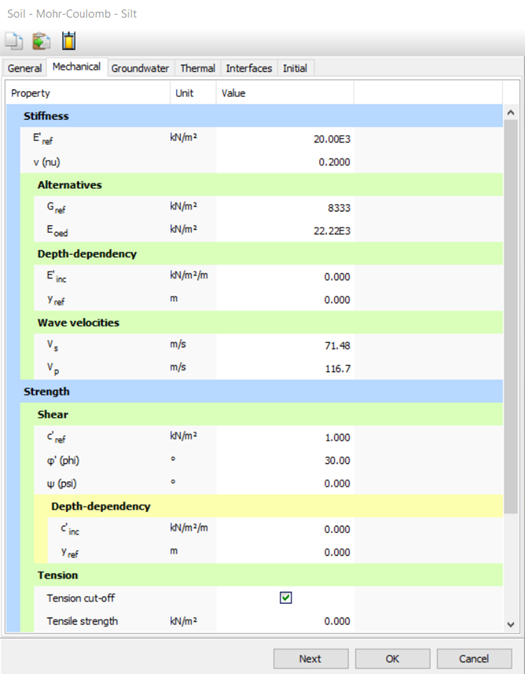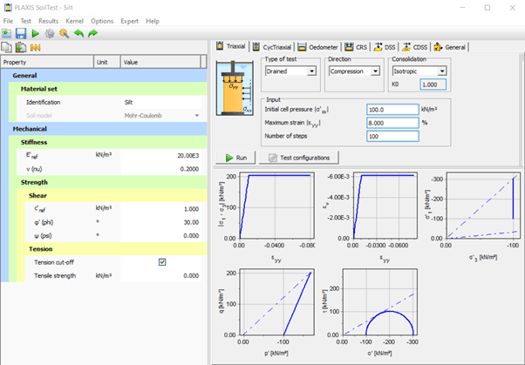Introduction
In order to obtain stresses and deformations in a geotechnical analysis, finite element analyses require stiffness parameters in addition to the traditional cohesion and friction angle strength parameters used in limit equilibrium safety analyses. The stiffness parameters depend on the constitutive model adopted for each material, but we can cite Young's elastic modulus and Poisson ratio as examples for the case of the Mohr-Coulomb model. Unit weight and the saturated coefficient of permeability, in the case of flow analysis, are also needed as input.
 Figure 1 - Soil mechanical parameters tab of the PLAXIS material set window for Mohr-Coulomb model
Figure 1 - Soil mechanical parameters tab of the PLAXIS material set window for Mohr-Coulomb model
Challenge
The challenge lies in defining the geotechnical parameters to represent the materials present in your analysis. These parameters can be obtained from laboratory tests, such as triaxial, oedometer, and direct shear strength, and from empirical correlations of field tests, such as SPT, CPTu, and DMT. The execution of site-specific field and laboratory tests are highly recommended but, in the absence of such tests, the parameters can also be obtained from geotechnical literature as an initial approach for your analysis. An initial analysis based on estimated parameters can even help to plan the detailed soil investigation, giving insight into the critical geotechnical parameters and locations.
Resolution
With laboratory tests in hand, PLAXIS offers a useful tool, called SoilTest, to calibrate the parameters for your geotechnical analysis. SoilTest allows you to simulate triaxial, cyclic triaxial, oedometer, CRS, DSS, and cyclic DSS tests in order to replicate the laboratory tests of your project. In addition, SoilTest's parameter optimization tool allows you to import real test data and optimize selected parameters to be used in your analysis.
 Figure 2 - PLAXIS SoilTest triaxial test simulation, Mohr-Coulomb model
Figure 2 - PLAXIS SoilTest triaxial test simulation, Mohr-Coulomb model
Besides the calibration of geotechnical parameters, SoilTest is a very nice learning tool. It enables engineers to understand various features of the constitutive model, including its limitations in representing the real soil behavior. For example, SoilTest can be used to verify how the linearity of the Mohr-Coulomb model differs from typical non-linear soil behavior under various loading conditions, which reminds us of the importance of the adoption of an appropriate constitutive model.
Conclusion
The finite element method gives a better understanding of the geotechnical projects that you work with. The definition of soil constitutive models and their parameters, part of the finite element method workflow, is a progressive process that improves the quality of the model representation of the real problem and requires laboratory and field geotechnical tests. PLAXIS SoilTest allows you to explore the implications of possible laboratory test results on your model and to calibrate the geotechnical parameters accordingly to the available laboratory tests.